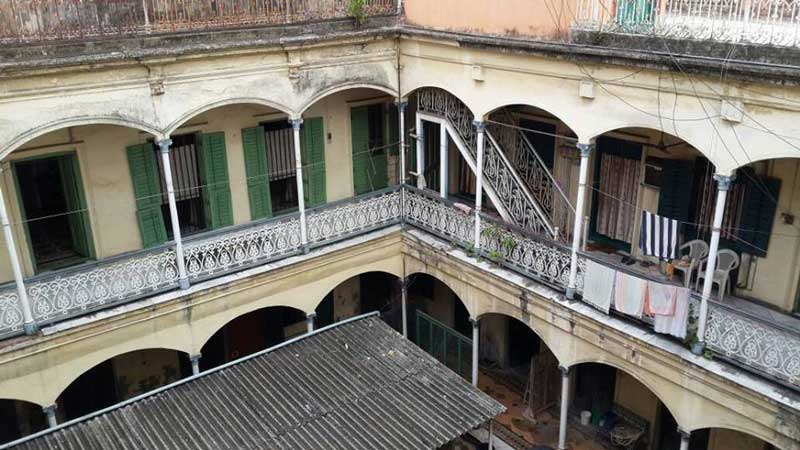
Located on Maharshi Debendra Road, in Jorasanko area, the Posta Rajbari was constructed by Raja Sukhomoy Roy, the grandson of Lakshmikant Roy.
Ramakanta and Lakshmikanta, known as the Dhar brothers (later known as Roy) of Saptagram, settled in this part of Bengal, during the early days of Calcutta, along with the Sheths, Basaks and the Subarna Banik bankers. Ramakanta was operating their business from Sutanuti, while Lakshmikanta took the responsibility of moving throughout the country for getting new clients. The British also traded here in Sutanati and it was the yarn of finest quality jute that drove Her Majesty’s men here. With time, the Dhar brothers became very rich and influential.
The relation shared by them with the British was a matter of envy and jealousy for the other traders. Lakshmikanta, alias Naku Dhar had good terms with Lord Clive and Warren Hastings. Before the battle of Plassey, the English were badly in need of funds to fight against the Marathas. At that time of crisis, Naku Dhar offered a loan of Rs 9 lakh to the East India Company. In exchange, the grateful British offered him the title of Maharaja, which he declined and proposed his grandson’s, his daughter Parvati’s son, name for the honour. This grandson of Lakshmikanta, his only heir, was Raja Sukhomoy Roy, the founder of the Posta Rajbari. It is said that, Lakshmikanta, alias Naku Dhar, introduced Nabakrishna Deb of Shobhabazar to Lord Clive.

The area got its name from Posta Ghat, a flight of stairs down the water body of River Hoogly. During those days the area was dreaded and notorious for the thugs and bandits. But Sukhamay Ray was competent enough to handle the situation. The Rajbari had ‘lethels’, paid band of skilled armed guards, who were specialized to fight with lathis or long batons.
It is said that, for the benefit of the pilgrims, the Posta Raj family during its heydays, took the initiative and drive to construct a road from Cuttack to Puri. During those days the property of the Raj family was vast, extending from Strand Road to Kalakar Street and Maharshi Debendra Road. A good chunk of the original property has already been lost due to land ceiling laws, more has been lost for road widening projects. But, fortunately three buildings have survived till date. They are known as Lalbari, Thakurbari, and Rajbari. Attached to the Rajbari is the temple of the family deity, the temple of Shyam Sundar Jew. Jew is the antiquated form of ‘Ji’. The oldest parts of the house were probably built between the late 1700’s and the early 1800’s. Lalbari, another portion of the house, was built in 1911.


The bay thrusting out of the Posta Rajbari is crowned with an octagonal room, with five windows and a door on the terrace. The small ornamental courtyard of the building consists of a ‘thakurdalan’, which was once used for worshipping. Today, it is used as the family car park, while the family deity, Shyamsundar Radharani, is worshipped in a nearby temple on Ratan Sarkar Garden Street. A lone marble statue of Radha Prasad, one of the ancestors of the family, stands unceremoniously in a corner.

The antiques, the artifacts and the marble statues of the Rajbari are sure to attract the eyes of the beholder. The unlighted chandeliers are now the dumb witnesses of its delighted nights of the past. The graceful statues of the smiling marble fairies are locked in a dark room. The unique stairs with intricate grills remains almost in the abyss of silence. However, the terrace is still beautiful. Today, the adjoining area of the Rajbari is madly busy and extremely crowded, full of bustle and fuss. But rarely anybody seems to have any time or interest to give it a glance.
